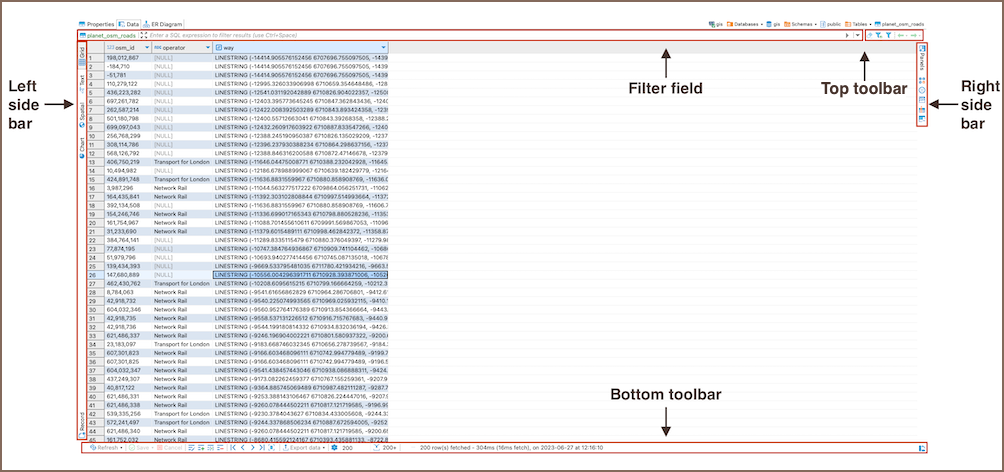A tree of database connections with their metadata structures down to the lowest level: tables, views, columns, indexes, procedures, triggers, storage entities (tablespaces, partitions), and security entities (users, roles) Ability to modify most metadata entities, depending on the database driver capabilities. Connect this free, multi-platform database tool to an ODBC data source. DBeaver Universal Database Tool Free multi-platform database tool for developers, database administrators, analysts and all people who need to work with databases. Supports all popular databases: MySQL, PostgreSQL, SQLite, Oracle, DB2, SQL Server, Sybase, MS Access, Teradata, Firebird, Apache Hive, Phoenix, Presto, etc. Traditional database development programmes allow the user to edit and run SQL scripts (totally or partially) in the same window, but this is not obvious with DBeaver. When I open a.sql script some drop down boxes in the button bar appear, that seem to serve as connection selectors.
- Dbeaver No Database Selected Data
- Dbeaver No Database Selected Download
- Dbeaver No Database Selected Version
- Dbeaver No Database Selected
- Dbeaver No Database Selected Type
- Dbeaver Sql Error No Database Selected
Dbeaver No Database Selected Data
DBeaver is a free, open source, graphical database management tool for database developers and administrators.

You can use DBeaver to create and manage databases across a wide range of database management systems (DBMSs). DBeaver works with most of the popular DBMSs, such as MySQL, PostgreSQL, MariaDB, SQLite, Oracle, DB2, SQL Server, Sybase, Microsoft Access, Teradata, Firebird, Derby, and more. In fact, DBeaver can be used on any database that has a JDBC or ODBC driver. It also works on some other databases that don’t have a standard xDBC driver, such as Mongo DB, Redis, and WMI.
DBeaver is a multi platform tool – it works on Windows, Linux, Mac, and Solaris.
Features

DBeaver has many of the typical features you’d expect from a GUI based database management tool. For example, there’s the Database Navigator that allows you to navigate through the list of databases, and expand them to navigate the database objects within each database. There’s also the SQL Editor with syntax highlighting and autocomplete.
Here’s a list of some of DBeaver’s main features:
- Graphical User Interface (GUI). Enables you to see a list of databases and their objects, and select options from menus by “pointing and clicking”. This is in contrast to a command line tool, where you’d need to remember the exact command to display a list of databases or perform other tasks.
- Data Editing. You can edit data from directly within the table (just like you might edit data within a spreadsheet).
- Database Analysis. Create visual diagrams of database objects and whole schemas and export as required. Also includes metadata management.
- SQL Editor. Enables you to create adhoc SQL queries and run them against the database. You can also load and save scripts as required. Some of the more popular features of the SQL Editor include syntax highlighting and autocomplete.
- Database Specific Features. DBeaver supports many of the features that are specific to certain DBMSs. For example, DBeaver supports views DDL and stored procedures in SQL Server, enum/set datatypes in MySQL, XML, Cursor datatypes support in Oracle and DB2, etc
- Themes/appearance. DBeaver comes with some default themes. You can switch between these within seconds. You can also change colors at a very granular level (such as the color of any parameters when written in the SQL Editor).
Community Edition
Os x yosemite to mojave. DBeaver Community Edition is free and open source. It’s distributed under the Apache License version 2.

Enterprise Edition
DBeaver also comes in an Enterprise Edition
Download DBeaver
To download DBeaver, head over to the DBeaver website download page. You can download the free Community Edition or a trial of the Enterprise Edition. There’s also an Eclipse plugin available for those using Eclipse.
Dbeaver No Database Selected Download
This topic explains how to work with the DBeaver plugin to create and manage databases in Zend Studio. DBeaver supports any database which has JDBC driver, and may handle any external data source which may or may not have a JDBC driver.
Prerequisistes
- Download and install DBeaver from http://dbeaver.jkiss.org/download/#eclipse
Connecting to a Database

This procedure explains how to establish a connection to a database using DBeaver.
To connect to a database : Mac os sierra usb boot.
Note: Under the Advanced tab, you can configure advanced connections settings, e.g., Character Coding.
|
Managing Connection Drivers
A database driver is a third-party library which provides the ability to work with specific database engines. The driver manager dialog allows you to create, delete and edit driver descriptions.
To manage your connection drivers:
Note: For a full breakdown of the available driver editing options, in the Menu bar, go to Help | Help Contents | DBeaver Help | Manage Connections | Driver editor dialog.
|
Working with your Database
Once you have established your connection, you can now begin to work with the data in your database using DBeaver.
Running SQL Queries and Scripts
This procedure will explain how to run SQL queries or scripts in your database using DBeaver.
To run SQL queries or scripts using DBeaver:
|
Note:
Dbeaver No Database Selected Version
For more information on working with data and metadata using DBeaver, select Help | Help Contents | DBeaver Help | Work with data from the menu-bar.
Setting Active Database
Dbeaver No Database Selected
Instead of manually running a 'use database' query with a database prefix for each SQL script or query you wish to run, you can define a database as being 'active' to directly run SQL scripts and queries.
Dbeaver No Database Selected Type
To set a database as active:
|
Dbeaver Sql Error No Database Selected
Copyright © 2017Rogue Wave Software Application loader 3.7 dmg download.
